How Agricultural Innovation Talents Influence County-Level Industrial Structure Upgrading: A Knowledge-Empowerment Perspective
Abstract
1. Introduction
2. Background and Literature Review
2.1. Industrial Structure Upgrading
2.2. Agricultural Innovation Talents
2.3. The Impact of Innovative Talents on Industrial Structure Upgrading
2.4. Literature Summary
2.5. Background of China’s “World-Class Disciplines” Construction Project
3. Theoretical and Hypothesis Development
3.1. Direct Influence of Agricultural Talents
3.2. Mechanism of Influence
4. Research Design
4.1. Data Source
4.2. Variable Setting
Dependent Variable
4.3. Independent Variable
4.4. Control Variables
4.5. Mechanism Variables
4.6. Descriptive Statistic Analysis
4.7. Methods
Basic Models
4.8. Mechanism Verification Model
5. Empirical Results and Discussion
5.1. Baseline Regression
5.2. Robustness Checks
5.3. Parallel Trend Test
5.4. Placebo Test
5.5. Variable Replacement
5.6. Sample Replacement
5.7. Model Replacement—Double Machine Learning
5.8. Endogeneity Test
5.9. Mechanism
Creating Knowledge: Promoting Industrial Integration
5.10. Spreading Knowledge: Responding to Information on Needs
5.11. Operating Knowledge: Guiding the Embedding of Digital Intelligence Elements
5.12. Heterogeneity Analysis
5.13. Futher Analysis: Spatial Spillover Effect
6. Conclusions and Policy Implications
6.1. Main Conclusions
6.2. Theoretical Contributions
6.3. Managerial Implications
6.4. Limitations and Future Research
Author Contributions
Funding
Institutional Review Board Statement
Data Availability Statement
Conflicts of Interest
References
- Wang, Y.; Li, L. Digital economy, industrial structure upgrading, and residents’ consumption: Empirical evidence from prefecture-level cities in China. Int. Rev. Econ. Financ. 2024, 92, 1045–1058. [Google Scholar] [CrossRef]
- Liu, Y.; Dai, L.; Long, H.; Woods, M.; Fois, F. Rural vitalization promoted by industrial transformation under globalization: The case of Tengtou village in China. J. Rural Stud. 2022, 95, 241–255. [Google Scholar] [CrossRef]
- Gereffi, G. International trade and industrial upgrading in the apparel commodity chain. J. Int. Econ. 1999, 48, 37–70. [Google Scholar] [CrossRef]
- Liang, S.; Tan, Q. Can the digital economy accelerate China’s export technology upgrading? Based on the perspective of export technology complexity. Technol. Forecast. Soc. Chang. 2024, 199, 123052. [Google Scholar] [CrossRef]
- Xue, F. Driving economic transition: The impact of cross-border e-commerce policy on the upgrading of service industry structure. Econ. Anal. Policy 2024, 84, 941–956. [Google Scholar] [CrossRef]
- Liu, Q.; Gao, J.; Li, S. The innovation model and upgrade path of digitalization-driven tourism industry: Longitudinal case study of OCT. Technol. Forecast. Soc. Chang. 2024, 200, 123127. [Google Scholar] [CrossRef]
- Cheong, T.S.; Wu, Y. Convergence and transitional dynamics of China’s industrial output: A county-level study using a new framework of distribution dynamics analysis. China Econ. Rev. 2018, 48, 125–138. [Google Scholar] [CrossRef]
- Lovell, S.T.; De Santis, S.; Nathan, C.A.; Olson, M.B.; Méndez, V.E.; Kominami, H.C.; Erickson, D.L.; Morris, K.S.; Morris, W.B. Integrating agroecology and landscape multifunctionality in Vermont: An evolving framework to evaluate the design of agroecosystems. Agric. Syst. 2010, 103, 327–341. [Google Scholar] [CrossRef]
- Ohlert, S.; Laibach, N.; Harms, R.; Bröring, S. Opportunity recognition in the tension field of knowledge and learning: The case of converging industries. J. Bus. Res. 2025, 186, 114993. [Google Scholar] [CrossRef]
- Peri, G. Determinants of knowledge flows and their effect on innovation. Rev. Econ. Stat. 2005, 87, 308–322. [Google Scholar] [CrossRef]
- Jones, C.I.; Tonetti, C. Nonrivalry and the Economics of Data. Am. Econ. Rev. 2020, 110, 2819–2858. [Google Scholar] [CrossRef]
- Xu, Y.B.; Wei, Y.; Zeng, X.; Yu, H.Q.; Chen, H.J. Big data development and labor income share: Evidence from China’s national big data comprehensive pilot zones. Econ. Anal. Policy 2024, 84, 1415–1437. [Google Scholar] [CrossRef]
- Du, J.; He, J.; Yang, J.; Chen, X. How industrial robots affect labor income share in task model: Evidence from Chinese A-share listed companies. Technol. Forecast. Soc. Chang. 2024, 208, 123655. [Google Scholar] [CrossRef]
- Agrawal, R.; Islam, N.; Samadhiya, A.; Shukla, V.; Kumar, A.; Upadhyay, A. Paving the way to environmental sustainability: A systematic review to integrate big data analytics into high-stake decision forecasting. Technol. Forecast. Soc. Chang. 2025, 214, 124060. [Google Scholar] [CrossRef]
- Daum, T.; Villalba, R.; Anidi, O.; Mayienga, S.M.; Gupta, S.; Birner, R. Uber for tractors? Opportunities and challenges of digital tools for tractor hire in India and Nigeria. World Dev. 2021, 144, 105480. [Google Scholar] [CrossRef]
- Birner, R.; Daum, T.; Pray, C. Who drives the digital revolution in agriculture? A review of supply-side trends, players and challenges. Appl. Econ. Perspect. Policy 2021, 43, 1260–1285. [Google Scholar] [CrossRef]
- Zhou, Y. Human capital, institutional quality and industrial upgrading: Global insights from industrial data. Econ. Chang. Restruct. 2018, 51, 1–27. [Google Scholar] [CrossRef]
- Zhao, Y.; He, F.; Feng, Y. Research on the Industrial Structure Upgrading Effect of the Employment Mobility of Graduates from China’s “Double First-Class” Colleges and Universities. Sustainability 2022, 14, 2353. [Google Scholar] [CrossRef]
- Hua, Z.; Kong, S.; Yu, Y. Talent magnets in China: Can talent attraction policies catalyze digital transformation in enterprises? China Econ. Rev. 2025, 90, 102376. [Google Scholar] [CrossRef]
- Xu, Y.; Li, X.; Tao, C.; Zhou, X. Connected knowledge spillovers, technological cluster innovation and efficient industrial structure. J. Innov. Knowl. 2022, 7, 100195. [Google Scholar] [CrossRef]
- Shabbir, M.Q.; Gardezi, S.B.W. Application of big data analytics and organizational performance: The mediating role of knowledge management practices. J. Big Data 2020, 7, 47. [Google Scholar] [CrossRef]
- Shen, H.; Qin, M.; Li, T.; Zhang, X.; Zhao, Y. Digital finance and industrial structure upgrading: Evidence from Chinese counties. Int. Rev. Financ. Anal. 2024, 95 Pt B, 103442. [Google Scholar] [CrossRef]
- Das, M.; Das, A.; Saikh, S. Estimating supply-demand mismatches for optimization of sustainable land use planning in a rapidly growing urban agglomeration (India). Land Use Policy 2024, 139, 107061. [Google Scholar] [CrossRef]
- Villano, R.A.; Koomson, I.; Nengovhela, N.B.; Mudau, L.; Burrow, H.M.; Bhullar, N. Relationships between Farmer Psychological Profiles and Farm Business Performance amongst Smallholder Beef and Poultry Farmers in South Africa. Agriculture 2023, 13, 548. [Google Scholar] [CrossRef]
- Liu, Y. An innovative talent training mechanism for maker education in colleges and universities based on the IPSO-BP-enabled technique. J. Innov. Knowl. 2023, 8, 100424. [Google Scholar] [CrossRef]
- Han, H.; Li, H.; Zhao, L. Determinants of Factor Misallocation in Agricultural Production and Implications for Agricultural Supply-Side Reform in China. China World Econ. 2018, 26, 22–42. [Google Scholar] [CrossRef]
- Clark, C. The Conditions of Economic Progress; Macmillan: London, UK, 1940. [Google Scholar]
- Chenery, H.B. Patterns of industrial growth. Am. Econ. Rev. 1960, 50, 624–654. [Google Scholar]
- Malerba, F. Sectoral Systems of Innovation: Concepts, Issues and Analyses of Six Major Sectors in Europe; Cambridge University Press: Cambridge, UK, 2004. [Google Scholar]
- Wang, X.; Wang, Q. Research on the impact of green finance on the upgrading of China’s regional industrial structure from the perspective of sustainable development. Resour. Policy 2021, 74, 102436. [Google Scholar] [CrossRef]
- Shi, D.; Wang, L.; Zhang, X.; Yu, T. Borrowed size and borrowed administrative power: Effects of high-speed rail network on industrial upgrading and variegated externalities in the Yangtze River Delta, China. J. Transp. Geogr. 2025, 123, 104113. [Google Scholar] [CrossRef]
- Ren, X.; Zeng, G.; Gozgor, G. How does digital finance affect industrial structure upgrading? Evidence from Chinese prefecture-level cities. J. Environ. Manag. 2023, 330, 117125. [Google Scholar] [CrossRef]
- Wu, N.; Liu, Z. Higher education development, technological innovation and industrial structure upgrade. Technol. Forecast. Soc. Chang. 2021, 162, 120400. [Google Scholar] [CrossRef]
- Romer, P.M. Endogenous Technological Change. J. Polit. Econ. 1990, 98, 71–102. [Google Scholar] [CrossRef]
- Cheng, H.; Song, M.; Liu, Y. Related technological density and regional industrial upgrading from perspective of product space theory: Evidence from China. Appl. Econ. 2024, 56, 5774–5788. [Google Scholar] [CrossRef]
- Cheng, L.; Liu, Q. Bureaucratic transfers and industrial structure changes in China: The role of superstar firms. Cities 2024, 150, 105043. [Google Scholar] [CrossRef]
- Feng, X.; Xu, M.; Li, J.; Gao, Z. Analysis of China’s industrial network structure and its resilience from the sectoral perspective. Habitat Int. 2024, 153, 103192. [Google Scholar] [CrossRef]
- Zhu, F.K.; Zhang, F.R.; Ke, X.L. Rural industrial restructuring in China’s metropolitan suburbs: Evidence from the land use transition of rural enterprises in suburban Beijing. Land Use Policy 2018, 74, 121–129. [Google Scholar] [CrossRef]
- Murakami, N. Changes in Japanese industrial structure and urbanization: Evidence from prefectural data. J. Asia Pac. Econ. 2015, 20, 385–403. [Google Scholar] [CrossRef]
- Emerick, K.; de Janvry, A.; Sadoulet, E.; Dar, M.H. Technological innovations, downside risk, and the modernization of agriculture. Am. Econ. Rev. 2016, 106, 1537–1561. [Google Scholar] [CrossRef]
- You, L.; Zhou, H.; Zhu, J.; Chen, C.; Wang, J. Involution and evolution of the flower industry and their implications for rural revitalization: A case study of Tonghai County, Yunnan Province, China. Habitat Int. 2025, 159, 103336. [Google Scholar] [CrossRef]
- Chen, C.; Gao, J.; Cao, H.; Chen, W. Unpacking the agricultural innovation and diffusion for modernizing the smallholders in rural China: From the perspective of agricultural innovation system and its governance. J. Rural Stud. 2024, 110, 103385. [Google Scholar] [CrossRef]
- de Janvry, A.; Sadoulet, E. Using agriculture for development: Supply- and demand-side approaches. World Dev. 2020, 133, 105003. [Google Scholar] [CrossRef]
- Hitka, M.; Ližbetinová, L. Human potential of talents in agriculture and forestry in context of Agriculture 4.0. Agric. Econ. 2023, 69, 223–233. [Google Scholar] [CrossRef]
- Schmookler, J.; Brownlee, O. Determinants of Inventive Activity. Am. Econ. Rev. 1962, 52, 165–176. [Google Scholar]
- Schultz, T.W. Transforming Traditional Agriculture; Yale University Press: New Haven, CT, USA, 1964. [Google Scholar]
- Klerkx, L.; Leeuwis, C. Establishment and embedding of innovation brokers at different innovation system levels: Insights from the Dutch agricultural sector. Technol. Forecast. Soc. Chang. 2009, 76, 849–860. [Google Scholar] [CrossRef]
- Puri, V. Agribusiness: A Great Career Opportunity for Talented People. Int. Food Agribus. Manag. Rev. 2012, 15, 1–4. [Google Scholar]
- Zhang, Y.; Kumar, S.; Huang, X.; Yuan, Y. Human capital quality and the regional economic growth: Evidence from China. J. Asian Econ. 2023, 86, 101593. [Google Scholar] [CrossRef]
- Carillo, M.F. Human capital composition and long-run economic growth. Econ. Model. 2024, 137, 106760. [Google Scholar] [CrossRef]
- Rogers, E.M.; Singhal, A.; Quinlan, M.M. An Integrated Approach to Communication Theory and Research; Routledge: New York, NY, USA, 2014. [Google Scholar]
- Murphy, K.M.; Shleifer, A.; Vishny, R.W. The Allocation of Talent: Implications for Growth. Q. J. Econ. 1991, 106, 503–530. [Google Scholar] [CrossRef]
- Rayner, A.J.; Cowling, K. Demand for farm tractors in the United States and the United Kingdom. Am. J. Agric. Econ. 1968, 50, 896–912. [Google Scholar] [CrossRef]
- Salvati, L.; Carlucci, M. The economic and environmental performances of rural districts in Italy: Are competitiveness and sustainability compatible targets? Ecol. Econ. 2011, 70, 2446–2453. [Google Scholar] [CrossRef]
- Griffin, J.J.; Youm, Y.N. Voluntarily disclosing prosocial behaviors in Korean firms. J. Bus. Ethics 2018, 153, 1017–1030. [Google Scholar] [CrossRef]
- Feder, G.; Just, R.E.; Zilberman, D. Adoption of agricultural innovations in developing countries: A survey. Econ. Dev. Cult. Chang. 1985, 33, 255–298. [Google Scholar] [CrossRef]
- Li, J.; Liu, H.; Chang, W.Y. Evaluating the Effect of Fiscal Support for Agriculture on Three-Industry Integration in Rural China. Agriculture 2024, 14, 912. [Google Scholar] [CrossRef]
- Vandermerwe, S.; Rada, J. Servitization of business: Adding value by adding services. Eur. Manag. J. 1988, 6, 314–324. [Google Scholar] [CrossRef]
- Coase, R.H. The Nature of the Firm. Economica 1937, 4, 386–405. [Google Scholar] [CrossRef]
- Zhao, X.; Xie, C.; Huang, L.; Wang, Y.; Han, T. How digitalization promotes the sustainable integration of culture and tourism for economic recovery. Econ. Anal. Policy 2023, 77, 988–1000. [Google Scholar] [CrossRef]
- Adner, R. Ecosystem as Structure: An Actionable Construct for Strategy. J. Manag. 2017, 43, 39–58. [Google Scholar] [CrossRef]
- Kaldor, N. Economic Growth and the Verdoorn Law: A Comment on Mr. Rowthorn’s Article. Econ. J. 1975, 85, 891–896. [Google Scholar] [CrossRef]
- Aghion, P.; Bloom, N.; Blundell, R.; Griffith, R.; Howitt, P. Competition and Innovation: An Inverted-U Relationship. Q. J. Econ. 2005, 120, 701–728. [Google Scholar]
- Dixit, A.K.; Stiglitz, J.E. Monopolistic Competition and Optimum Product Diversity. Am. Econ. Rev. 1977, 67, 297–308. [Google Scholar]
- Schumpeter, J.A. Capitalism, Socialism and Democracy; Harper and Brothers: New York, NY, USA, 1942. [Google Scholar]
- Bresnahan, T.F.; Trajtenberg, M. General purpose technologies: Engines of growth? J. Econom. 1995, 65, 83–108. [Google Scholar] [CrossRef]
- Kongsamut, P.; Rebelo, S.; Xie, D. Beyond balanced growth. Rev. Econ. Stud. 2001, 68, 869–882. [Google Scholar] [CrossRef]
- Comin, D.; Lashkari, D.; Mestieri, M. Structural change with long-run income and price effects. Econometrica 2021, 89, 311–374. [Google Scholar] [CrossRef]
- Maslow, A.H. A theory of human motivation. Psychol. Rev. 1943, 50, 370–396. [Google Scholar] [CrossRef]
- Taylor, L.D.; Houthakker, H.S. Consumer Demand in the United States: Prices, Income, and Consumption Behavior; Springer: New York, NY, USA, 2010. [Google Scholar]
- Hsieh, C.T.; Klenow, P.J. Misallocation and manufacturing TFP in China and India. Q. J. Econ. 2009, 124, 1403–1448. [Google Scholar] [CrossRef]
- Keynes, J.M. The General Theory of Employment, Interest, and Money; Macmillan: London, UK, 1936. [Google Scholar]
- Aghion, P.; Harris, C.; Howitt, P.; Vickers, J. Competition, imitation and growth with step-by-step innovation. Rev. Econ. Stud. 2001, 68, 467–492. [Google Scholar] [CrossRef]
- Fabrizio, K.R.; Thomas, L.G. The impact of local demand on innovation in a global industry. Strat. Manag. J. 2012, 33, 42–64. [Google Scholar] [CrossRef]
- Coccia, M. Sources of technological innovation: Radical and incremental innovation problem-driven to support competitive advantage of firms. Technol. Anal. Strat. Manag. 2016, 29, 1048–1061. [Google Scholar] [CrossRef]
- Xia, L.; Han, Q.; Yu, S. Industrial intelligence and industrial structure change: Effect and mechanism. Int. Rev. Econ. Financ. 2024, 93 Pt A, 1494–1506. [Google Scholar] [CrossRef]
- Goldfarb, A.; Prince, J. Internet adoption and usage patterns are different: Implications for the digital divide. Inf. Econ. Policy 2008, 20, 2–15. [Google Scholar] [CrossRef]
- Acemoglu, D.; Restrepo, P. Robots and Jobs: Evidence from US Labor Markets. J. Polit. Econ. 2020, 128, 2188–2244. [Google Scholar] [CrossRef]
- Zhu, T.T.; Zeng, H. Does reputation matter? The impact of China’s double world-class policy on the attraction of high-quality students. Int. J. Educ. Dev. 2025, 114, 103259. [Google Scholar] [CrossRef]
- Smith, H.L.; Glasson, J.; Chadwick, A. The geography of talent: Entrepreneurship and local economic development in Oxfordshire. Entrep. Reg. Dev. 2005, 17, 449–478. [Google Scholar] [CrossRef]
- Paci, R.; Marrocu, E. Knowledge Assets and Regional Performance. Growth Chang. 2013, 44, 228–257. [Google Scholar] [CrossRef]
- Rambachan, A.; Roth, J. A More Credible Approach to Parallel Trends. Rev. Econ. Stud. 2023, 90, 2555–2591. [Google Scholar] [CrossRef]
- Andersson, R.; Quigley, J.M.; Wilhelmsson, M. Urbanization, productivity, and innovation: Evidence from investment in higher education. J. Urban Econ. 2009, 66, 2–15. [Google Scholar] [CrossRef]
- Li, W.; He, W. Revenue-increasing effect of rural e-commerce: A perspective of farmers’ market integration and employment growth. Econ. Anal. Policy 2024, 81, 482–493. [Google Scholar] [CrossRef]
- Chernozhukov, V.; Chetverikov, D.; Demirer, M.; Duflo, E.; Hansen, C.; Newey, W.; Robins, J. Double/debiased machine learning for treatment and structural parameters. Econom. J. 2018, 21, C1–C68. [Google Scholar] [CrossRef]
- Graafland, J.; Lous, B. Income Inequality, Life Satisfaction Inequality and Trust: A Cross Country Panel Analysis. J. Happiness Stud. 2019, 20, 1717–1737. [Google Scholar] [CrossRef]
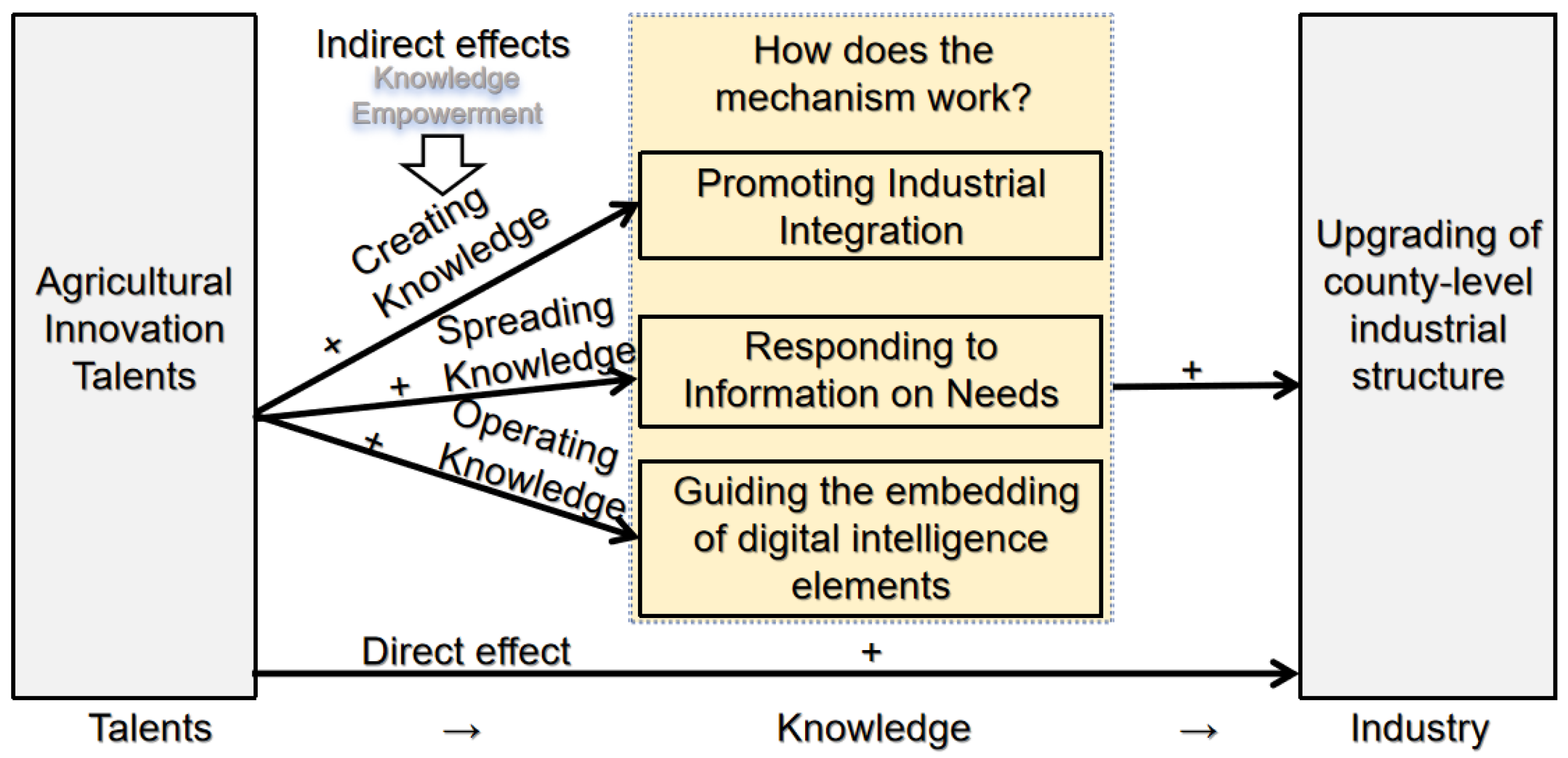
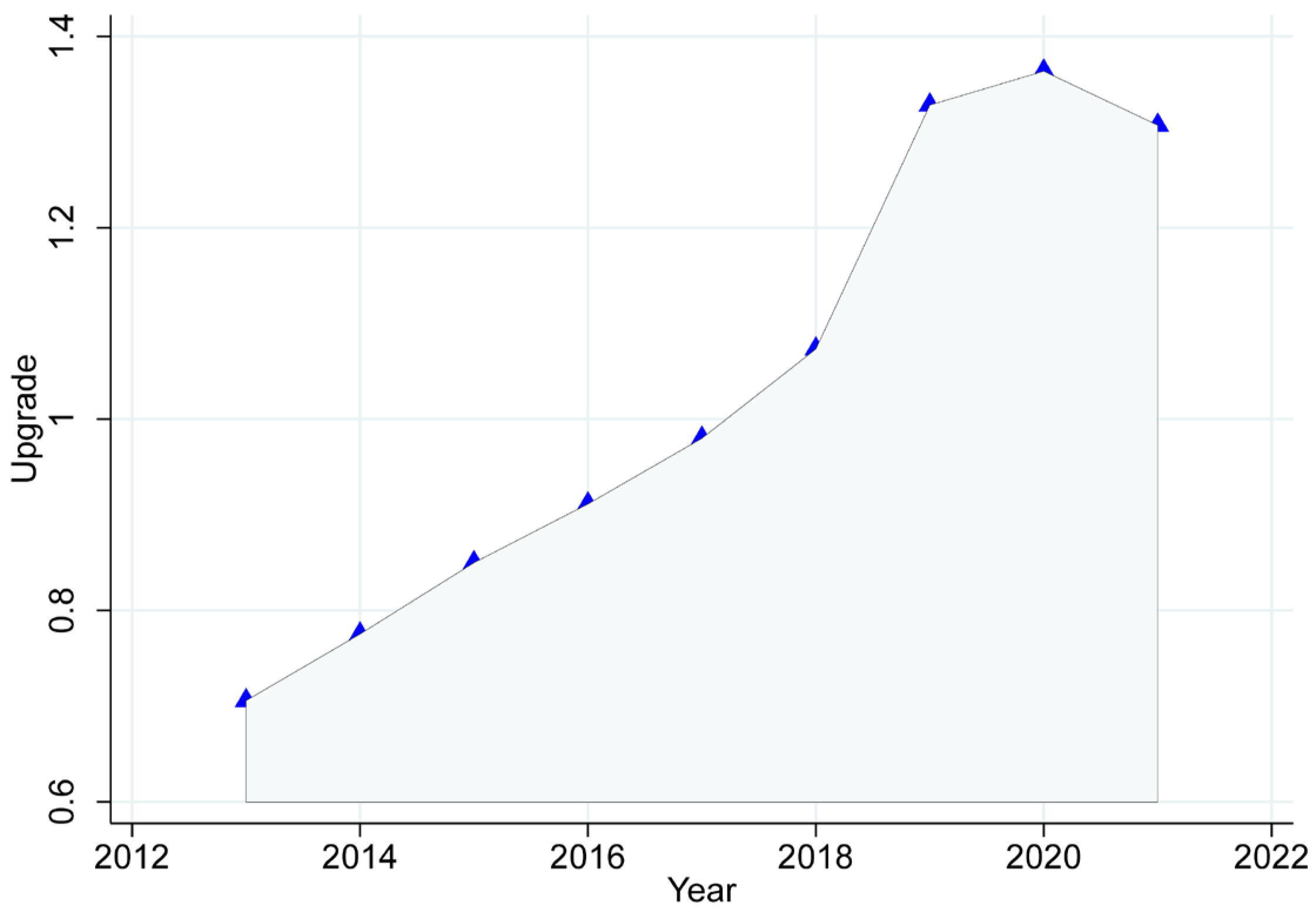
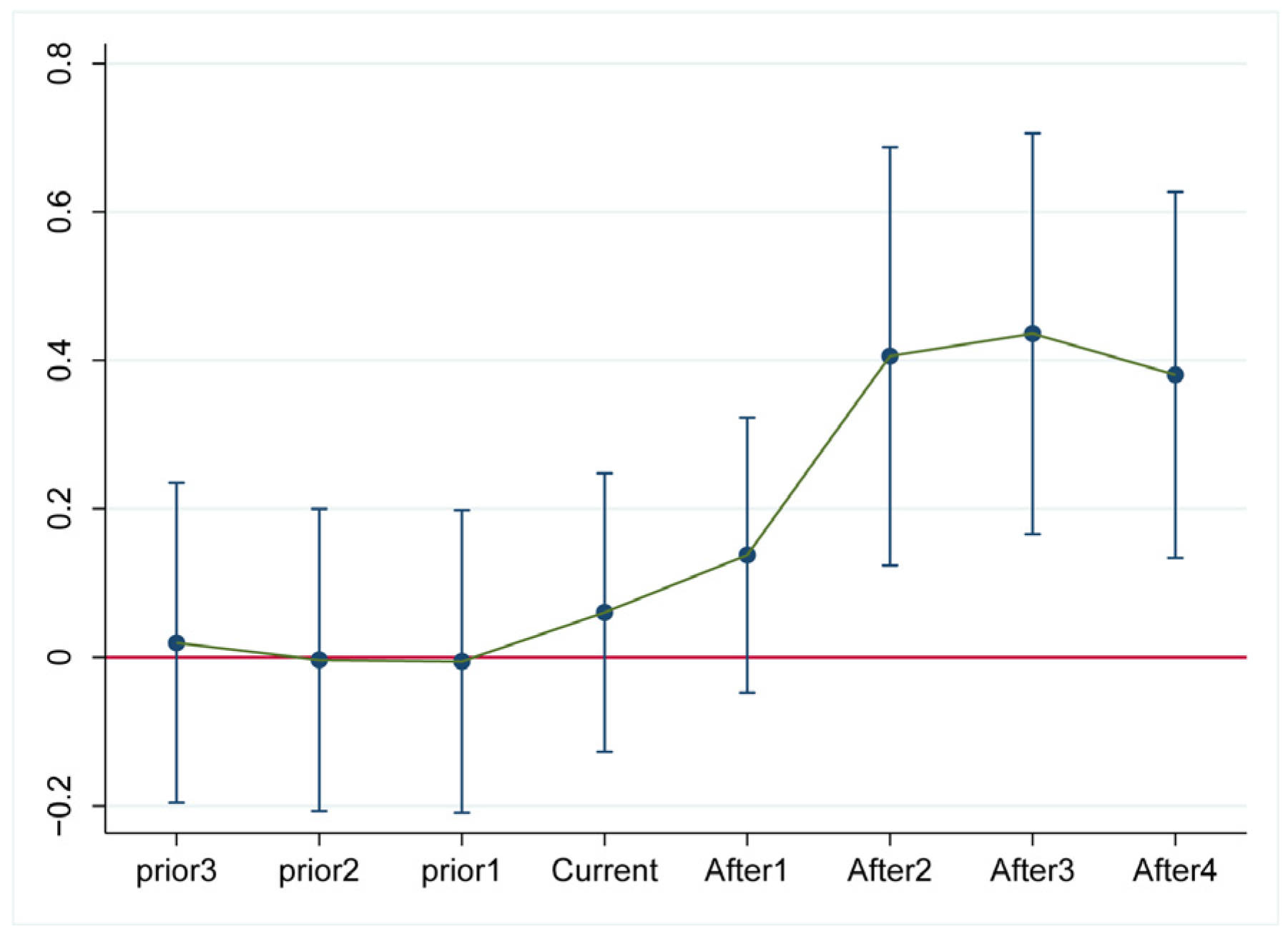
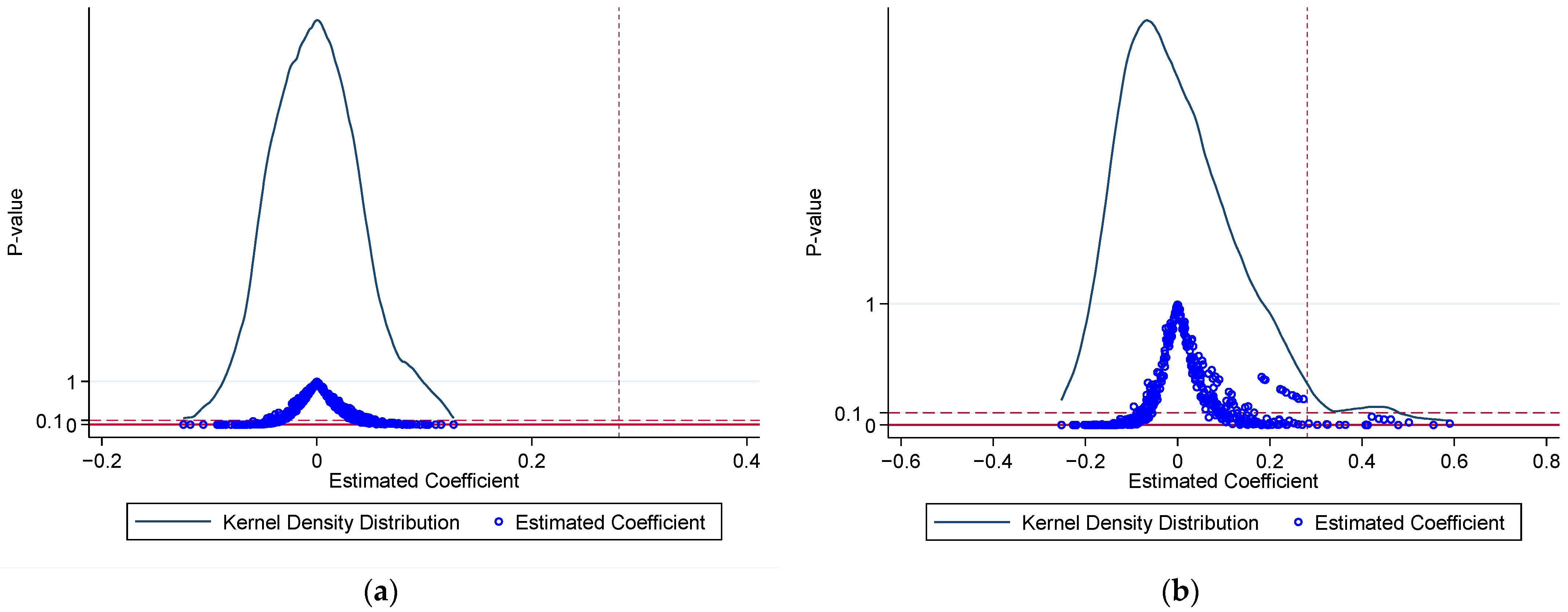
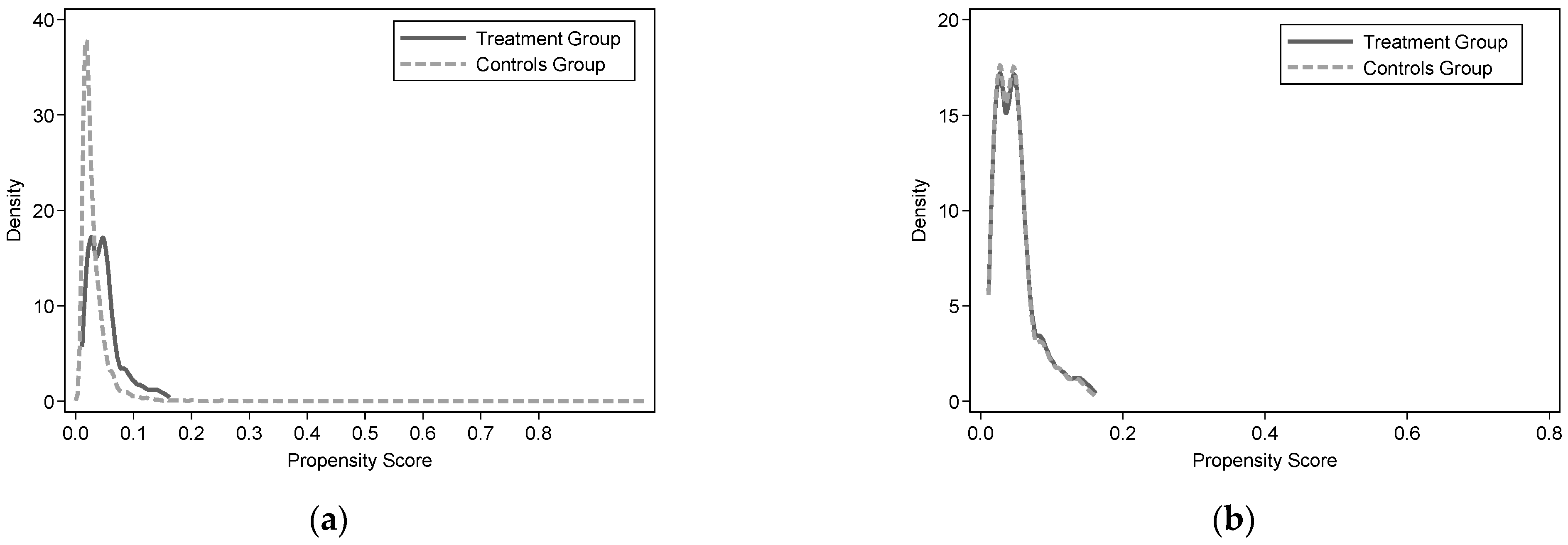

| Variables | Meaning and Assignment of Variables | Obs | Mean | S.D. |
|---|---|---|---|---|
| Dependent variable | ||||
| Upgrade | The relative proportion of the value of output of the tertiary sector to that of the secondary sector at the county level. | 15,939 | 1.364 | 1.421 |
| Independent variable | ||||
| Talent | Does the city to which the county belongs have a “World-Class Agricultural Disciplines” construction project, and is the year 2017 or later? 1 = Yes; 0 = No. | 15,939 | 0.018 | 0.133 |
| Control variables | ||||
| Development | The ratio of county-level GDP to county-level total population. | 15,939 | 4.545 | 4.371 |
| Fiscal | The ratio of county-level fiscal revenue to county-level fiscal expenditure. | 15,939 | 0.329 | 0.234 |
| Finance | The ratio of the year-end balance of financial institution loans at the county level to county-level fiscal expenditure. | 15,939 | 0.76 | 0.479 |
| Education | The ratio of the total number of primary and secondary school students at the county level to the total population at the county level. | 15,939 | 0.118 | 0.05 |
| Inform | The ratio of the number of fixed telephone users at the county level to the total population at the county level. | 15,939 | 0.099 | 0.097 |
| Food | The ratio of the total grain output at the county level to the total population at the county level. | 15,939 | 0.653 | 1.048 |
| Industry | The ratio of the number of large-scale industrial enterprises at the county level to the administrative area of the county. | 15,939 | 0.104 | 0.223 |
| Mechanism variables | ||||
| Transformation | The ratio of the total value of output of the secondary and tertiary sectors at the county level to the total value of output of the primary sector at the county level. | 15,939 | 8.073 | 11.327 |
| Light | The average nighttime light intensity at the county level. | 15,831 | 5.861 | 8.433 |
| Density | The ratio of the total retail sales of consumer goods at the county level to the administrative area of the county. | 14,846 | 0.062 | 0.13 |
| Avergae | The ratio of the total retail sales of consumer goods at the county level to the total population at the county level. | 14,846 | 1.469 | 1.326 |
| Robot | The density of robot installations at the county level. | 15,939 | 0.011 | 0.023 |
| E-commerce | The number of enterprises engaged in e-commerce transactions at the county level. | 15,939 | 0.002 | 0.004 |
| Variables | (1) | (2) | (3) | (4) | (5) | (6) | (7) | (8) |
|---|---|---|---|---|---|---|---|---|
| Talent | 0.2950 *** | 0.3063 *** | 0.2918 *** | 0.2590 *** | 0.2900 *** | 0.2953 *** | 0.3032 *** | 0.2811 *** |
| (0.0661) | (0.0649) | (0.0660) | (0.0669) | (0.0660) | (0.0661) | (0.0660) | (0.0652) | |
| Development | −0.0440 *** | −0.0664 *** | ||||||
| (0.0105) | (0.0121) | |||||||
| Fiscal | −0.1488 *** | −0.0759 * | ||||||
| (0.0503) | (0.0445) | |||||||
| Finance | 0.3189 *** | 0.2332 *** | ||||||
| (0.0489) | (0.0473) | |||||||
| Education | −0.5025 ** | −1.7589 ** | ||||||
| (0.2122) | (0.6856) | |||||||
| Inform | 0.0277 | 0.3014 *** | ||||||
| (0.0712) | (0.1154) | |||||||
| Food | 0.0934 | 0.2541 *** | ||||||
| (0.0577) | (0.0625) | |||||||
| Industry | −0.4339 *** | |||||||
| (0.1070) | ||||||||
| Constant | 1.3584 *** | 1.5583 *** | 1.4074 *** | 1.1168 *** | 1.4177 *** | 1.3556 *** | 1.2972 *** | 1.5650 *** |
| (0.0067) | (0.0485) | (0.0175) | (0.0379) | (0.0260) | (0.0098) | (0.0384) | (0.0833) | |
| Year Effect | Yes | Yes | Yes | Yes | Yes | Yes | Yes | Yes |
| County Effect | Yes | Yes | Yes | Yes | Yes | Yes | Yes | Yes |
| R2 | 0.6604 | 0.6643 | 0.6605 | 0.6635 | 0.6606 | 0.6604 | 0.6626 | 0.6754 |
| Obs. | 15939 | 15939 | 15939 | 15939 | 15939 | 15939 | 15939 | 15939 |
| Variables | (1) | (2) | (3) | (4) | (5) | (6) |
|---|---|---|---|---|---|---|
| Core Explanatory Variables | Dependent Variables | Control Variables | ||||
| Talent | 0.075 *** | 0.088 *** | 0.166 *** | 0.146 *** | 0.307 *** | 0.294 *** |
| (0.026) | (0.026) | (0.034) | (0.033) | (0.067) | (0.067) | |
| Constant | 1.348 *** | 1.549 *** | 0.997 *** | 1.116 *** | 1.135 *** | 1.666 *** |
| (0.009) | (0.083) | (0.004) | (0.045) | (0.252) | (0.218) | |
| Control Variables | No | Yes | No | Yes | Yes | Yes |
| Year Effect | Yes | Yes | Yes | Yes | Yes | Yes |
| County Effect | Yes | Yes | Yes | Yes | Yes | Yes |
| R2 | 0.660 | 0.675 | 0.690 | 0.700 | 0.685 | 0.685 |
| Obs. | 15,939 | 15,939 | 15,939 | 15,939 | 14,000 | 14,000 |
| Variables | (1) | (2) | (3) | (4) | (5) | (6) | (7) | (8) |
|---|---|---|---|---|---|---|---|---|
| PSM-DID | Isolating the Treatment Effect from Other Empirical Confounders | |||||||
| Talent | 0.2929 *** | 0.3149 *** | 0.3594 *** | 0.3526 *** | 0.3509 *** | 0.3737 *** | 0.1224 ** | 0.1146 ** |
| (0.0664) | (0.0641) | (0.0710) | (0.0698) | (0.0841) | (0.0825) | (0.0554) | (0.0564) | |
| Constant | 1.3278 *** | 1.5059 *** | 1.3621 *** | 1.5559 *** | 1.2149 *** | 1.0910 *** | 1.2633 *** | 1.3704 *** |
| (0.0067) | (0.0954) | (0.0067) | (0.0835) | (0.0067) | (0.0771) | (0.0062) | (0.0682) | |
| Control Variables | No | Yes | No | Yes | No | Yes | No | Yes |
| Year Effect | Yes | Yes | Yes | Yes | Yes | Yes | Yes | Yes |
| County Effect | Yes | Yes | Yes | Yes | Yes | Yes | Yes | Yes |
| R2 | 0.6730 | 0.6881 | 0.6606 | 0.6753 | 0.6948 | 0.7152 | 0.6589 | 0.6704 |
| Obs. | 14,864 | 14,864 | 15,777 | 15,777 | 11,095 | 11,095 | 14,514 | 14,514 |
| Vairables | (1) Lasso (kfolds = 4) | (2) Lasso (kfolds = 5) | (3) Gradboost (kfolds = 4) | (4) Gradboost (kfolds = 5) |
|---|---|---|---|---|
| Talent | 0.2291 *** | 0.2254 *** | 0.5246 *** | 0.5509 *** |
| (0.0640) | (0.0684) | (0.0916) | (0.0956) | |
| Constant | −0.0007 | 0.0012 | 0.0023 | 0.0046 |
| (0.0070) | (0.0072) | (0.0079) | (0.0079) | |
| Control Variables | Yes | Yes | Yes | Yes |
| Year Effect | Yes | Yes | Yes | Yes |
| County Effect | Yes | Yes | Yes | Yes |
| Obs. | 15,939 | 15,939 | 15,939 | 15,939 |
| Varibales | (1) First Stage | (2) Second Stage | (3) First stage | (4) Second Stage |
|---|---|---|---|---|
| IV_Non-sate | 0.0756 *** | 0.0849 *** | ||
| (0.0116) | (0.0118) | |||
| Talent | 5.658 *** | 5.273 *** | ||
| (1.759) | (1.492) | |||
| Control | No | No | Yes | Yes |
| Year Effect | Yes | Yes | Yes | Yes |
| County Effect | Yes | Yes | Yes | Yes |
| Kleibergen–Paap rk Wald F | 42.265 {16.38} | 51.861 {16.38} | ||
| Kleibergen–Paap rk LM | 48.382 *** | 59.390 *** | ||
| Obs. | 15,939 | 15,939 | ||
| Variables | (1) Transformation | (2) Transformation | (3) Light | (4) Light |
|---|---|---|---|---|
| Talent | 2.9735 *** | 2.7006 *** | 1.3986 *** | 1.2072 *** |
| (0.5360) | (0.5148) | (0.2178) | (0.2080) | |
| Constant | 8.0199 *** | 5.5678 *** | 5.8357 *** | 5.2585 *** |
| (0.0280) | (0.6069) | (0.0150) | (0.1964) | |
| Control Variables | No | Yes | No | Yes |
| Year Effect | Yes | Yes | Yes | Yes |
| County Effect | Yes | Yes | Yes | Yes |
| R2 | 0.9090 | 0.9271 | 0.9546 | 0.9563 |
| Obs. | 15,939 | 15,939 | 15,831 | 15,831 |
| Variables | (1) Density | (2) Density | (3) Average | (4) Average |
|---|---|---|---|---|
| Talent | 0.0555 *** | 0.0597 *** | 0.5406 *** | 0.4927 *** |
| (0.0065) | (0.0065) | (0.0673) | (0.0570) | |
| Constant | 0.0611 *** | 0.0369 *** | 1.4610 *** | 0.2524 *** |
| (0.0004) | (0.0079) | (0.0060) | (0.0937) | |
| Control Variables | No | Yes | No | Yes |
| Year Effect | Yes | Yes | Yes | Yes |
| County Effect | Yes | Yes | Yes | Yes |
| R2 | 0.8618 | 0.8747 | 0.7068 | 0.8424 |
| Obs. | 14,841 | 14,841 | 14,841 | 14,841 |
| Variables | (1) Robot | (2) Robot | (3) E-commerce | (4) E-commerce |
|---|---|---|---|---|
| Talent | 0.0108 *** | 0.0121 *** | 0.0010 *** | 0.0011 *** |
| (0.0018) | (0.0018) | (0.0002) | (0.0002) | |
| Constant | 0.0107 *** | −0.0014 | 0.0024 *** | 0.0017 *** |
| (0.0001) | (0.0022) | (0.0000) | (0.0002) | |
| Control Variables | No | Yes | No | Yes |
| Year Effect | Yes | Yes | Yes | Yes |
| County Effect | Yes | Yes | Yes | Yes |
| R2 | 0.7179 | 0.7961 | 0.9284 | 0.9435 |
| Obs. | 15,939 | 15,939 | 15,939 | 15,939 |
| Variables | (1) Gap | (2) Savings |
|---|---|---|
| Talent | 0.4068 *** | 0.1941 *** |
| (0.0872) | (0.0663) | |
| Talent × Gap | −0.4009 *** | |
| (0.1029) | ||
| Talent × Savings | 0.4673 ** | |
| (0.1941) | ||
| Constant | 1.5754 *** | 1.5169 *** |
| (0.0891) | (0.0875) | |
| Control Variables | Yes | Yes |
| Year Effect | Yes | Yes |
| County Effect | Yes | Yes |
| R2 | 0.6725 | 0.6759 |
| Obs. | 13,554 | 15,894 |
| Variables | (1) 25% Quartile | (2) 50% Quartile | (3) 75% Quartile |
|---|---|---|---|
| Talent | 0.1344 *** | 0.1206 *** | 0.3279 *** |
| (0.0240) | (0.0399) | (0.1042) | |
| Constant | 0.6904 *** | 1.0335 *** | 1.5750 *** |
| (0.0163) | (0.0267) | (0.0778) | |
| Control Variables | Yes | Yes | Yes |
| Year Effect | Yes | Yes | Yes |
| County Effect | Yes | Yes | Yes |
| R2 | 0.1263 | 0.1919 | 0.1762 |
| Obs. | 15,939 | 15,939 | 15,939 |
| (1) Direct | (2) Indirect | (3) Total | (4) Direct | (5) Indirect | (6) Total | |
|---|---|---|---|---|---|---|
| Talent | 0.2565 *** | 37.6505 *** | 37.9070 *** | 0.1376 * | 86.2270 *** | 86.3646 *** |
| (0.0813) | (7.6310) | (7.6284) | (0.0770) | (21.0062) | (21.0078) | |
| rho | 0.9203 *** | 0.9468 *** | ||||
| (0.0178) | (0.0104) | |||||
| sigma2_e | 0.6951 *** | 0.6606 *** | ||||
| (0.1054) | (0.1048) | |||||
| Control Variables | No | Yes | ||||
| Year Effect | Yes | Yes | ||||
| County Effect | Yes | Yes | ||||
| R2 | 0.0102 | 0.0459 | ||||
| Obs. | 15,786 | 15,786 | ||||
Disclaimer/Publisher’s Note: The statements, opinions and data contained in all publications are solely those of the individual author(s) and contributor(s) and not of MDPI and/or the editor(s). MDPI and/or the editor(s) disclaim responsibility for any injury to people or property resulting from any ideas, methods, instructions or products referred to in the content. |
© 2025 by the authors. Licensee MDPI, Basel, Switzerland. This article is an open access article distributed under the terms and conditions of the Creative Commons Attribution (CC BY) license (https://creativecommons.org/licenses/by/4.0/).
Share and Cite
Lv, L.; Dai, F. How Agricultural Innovation Talents Influence County-Level Industrial Structure Upgrading: A Knowledge-Empowerment Perspective. Agriculture 2025, 15, 1500. https://doi.org/10.3390/agriculture15141500
Lv L, Dai F. How Agricultural Innovation Talents Influence County-Level Industrial Structure Upgrading: A Knowledge-Empowerment Perspective. Agriculture. 2025; 15(14):1500. https://doi.org/10.3390/agriculture15141500
Chicago/Turabian StyleLv, Lizhan, and Feng Dai. 2025. "How Agricultural Innovation Talents Influence County-Level Industrial Structure Upgrading: A Knowledge-Empowerment Perspective" Agriculture 15, no. 14: 1500. https://doi.org/10.3390/agriculture15141500
APA StyleLv, L., & Dai, F. (2025). How Agricultural Innovation Talents Influence County-Level Industrial Structure Upgrading: A Knowledge-Empowerment Perspective. Agriculture, 15(14), 1500. https://doi.org/10.3390/agriculture15141500






